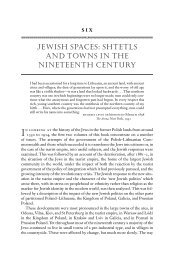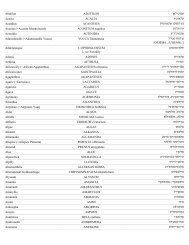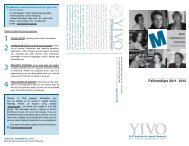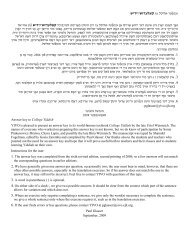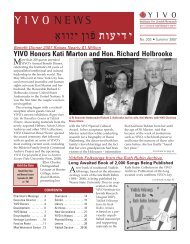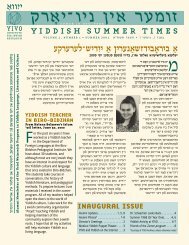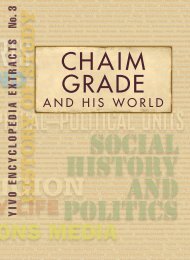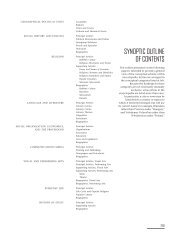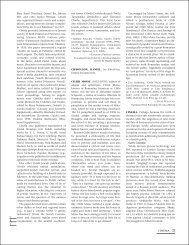Here - YIVO Institute for Jewish Research
Here - YIVO Institute for Jewish Research
Here - YIVO Institute for Jewish Research
You also want an ePaper? Increase the reach of your titles
YUMPU automatically turns print PDFs into web optimized ePapers that Google loves.
It is difficult to say what compels an artist to build hiswork almost exclusively out of archival images created bysomeone else. Perhaps the distressing signs of decay visibleon nearly every inch of celluloid, and the lasting sense ofsatisfaction that he might save from oblivion the memoriesstored thereon. Or yet a weariness of the Great Narrativesthrough which the complex history of the 20th century isusually told, and the desire to portray the past through theeyes of those omitted in such master narrations.In the case of Forgács, one of the best known Hungarianexponents of found footage, the artist’s fascination canbe traced back to 1983, when he founded the PrivátFotó és Film Archívum (Private Photo and Film Archive)in Budapest. To gather its collection, the artist traveledthroughout Hungary, visiting family homes, archivingold films and conducting interviews. The collection thusbuilt inspired the “Private Hungary” series (1998-2002),whose fourteen parts present the chronicles of severalHungarian families, juxtaposing impressions of life inHungary with important political events. “In Hungary […]eleven different political rules existed between 1918 and1989, (including three revolutions and two counterrevolutions)[…] As a consequence, any family home-moviecollection […] will show the unique sign of the times,”Forgács explained in an interview.In “Private Hungary”, next to the story of the Petö family,we also get to know the story of the Hungarian bishopLaszlo Ravasz, persecuted both by the Nazis and theCommunists (The Bishop’s Garden, “Private Hungary”14, 2002). We also discover the stories of bourgeoisfamilies fighting against the nightmare of Communism(Either – Or, “Private Hungary” 3, 1989), or the film diaryof Baroness Jeszenszky (The Notes of a Lady, “PrivateHungary” 8, 1994), a rare record of the life once led byHungarian aristocracy. The amateur filmmakers whoregistered these films all shared an enormous passion<strong>for</strong> cinematography as well as an enthusiasm <strong>for</strong> newtechnologies in general. For them, the camera was amarvelous, nearly magical device.While working on the subsequent parts of “PrivateHungary” the artist also made ef<strong>for</strong>ts to obtain homemovies from all over Central Europe as well as otherEuropean countries. As a result, Forgács’ portfolio of4243Péter Forgács / The Klezmatics



